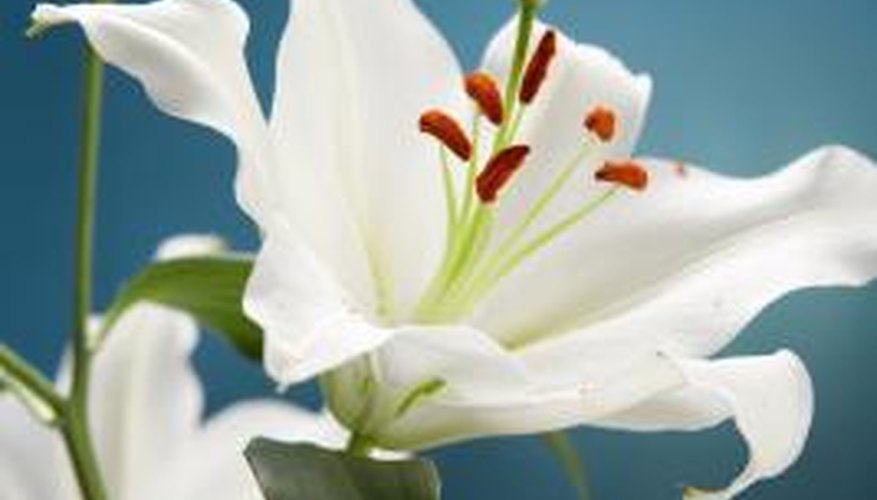People have cultivated lilies for more than 3,000 years, dating back to ancient Egypt. Lilies, which belong to the genus Lilium and grow from bulbs, are distant relatives of tulips. True lilies have sturdy stems that can grow to 6 feet or more. Clusters of large flowers bloom at the end of each stem. Many plants known as lilies, including calla lilies and day lilies, are not true lilies. To determine whether you have a true lily, look at the bulb. It should have five to eight thick, overlapping scales with no protective skin.
Sprouting Time Frame
Newly planted lily bulbs take their time sending up shoots. Plant your lilies in September or October for the best flowering results the next summer. If you plant in the fall, your lilies will sprout in about six months, when the spring brings warmer soil temperatures. Plant in the spring or summer, and the lilies will sprout in about a month. They won't thrive after a spring planting -- you'll get perhaps one or two short stalks with one to two flowers on it, rather than the eight to 10 flowers per stalk that healthy lilies produce. Once lily bulbs have overwintered for a season, normal blooming will begin the next summer.
- Newly planted lily bulbs take their time sending up shoots.
- If you plant in the fall, your lilies will sprout in about six months, when the spring brings warmer soil temperatures.
More Planting Tips
Lilies need room to grow. Plant them six to 12 inches apart and 4 to 6 inches deep. Lilies grow best in full sun, so find a spot in your garden with plenty of natural light. Lilies also require well-drained soil. Avoid spots that collect standing water after rain. If you have clay or sandy soil, add organic matter such as dead leaves or store-bought peat or compost to improve drainage and control moisture. If you can't plant your lilies immediately because the ground is frozen, store them in your refrigerator or garage at temperatures above -2.22 degrees Celsius but below 15.6 degrees Celsius. Don't expose lily bulbs to light, or they may sprout before you're ready to plant.
- Plant them six to 12 inches apart and 4 to 6 inches deep.
- If you can't plant your lilies immediately because the ground is frozen, store them in your refrigerator or garage at temperatures above -2.22 degrees Celsius but below 15.6 degrees Celsius.
Caring for Lilies
Protect your lily bulbs through cold winters by laying 6 inches of mulch, such as leaves or wood chips, to delay soil freezing and protect emerging shoots from late frosts. Give your lilies a slow-release, high-nitrogen fertiliser when shoots first emerge, and apply a high-phosphorous fertiliser a month after the bulbs sprout to boost flower production. Keep soil moist until flowers begin to bloom. Water early in the morning and at the base of the plant to keep leaves dry and prevent fungal diseases. Lilies tolerate drier conditions once they blossom. Rabbits will eat new shoots, so install chicken wire or another barrier around your lilies. Remove flowers past their peak to encourage more blooms. Remove dead stalks in the fall to let bulbs go dormant for the winter.
- Protect your lily bulbs through cold winters by laying 6 inches of mulch, such as leaves or wood chips, to delay soil freezing and protect emerging shoots from late frosts.
Best Varieties for New Growers
Many lily varieties are very sensitive to their growing conditions and require the expert care of an experienced cultivator. But a few types thrive with standard garden care. If you're new to lily growing, try hardy Asiatic varieties such as the dark red Landini or the pastel Pink River. Hybrid lilies are disease-resistant, vigorous growers. Popular hybrids include Red Velvet and Black Beauty. If you're looking for a hardy lily that grows well in shadier gardens, try martagon lilies.
- Many lily varieties are very sensitive to their growing conditions and require the expert care of an experienced cultivator.
